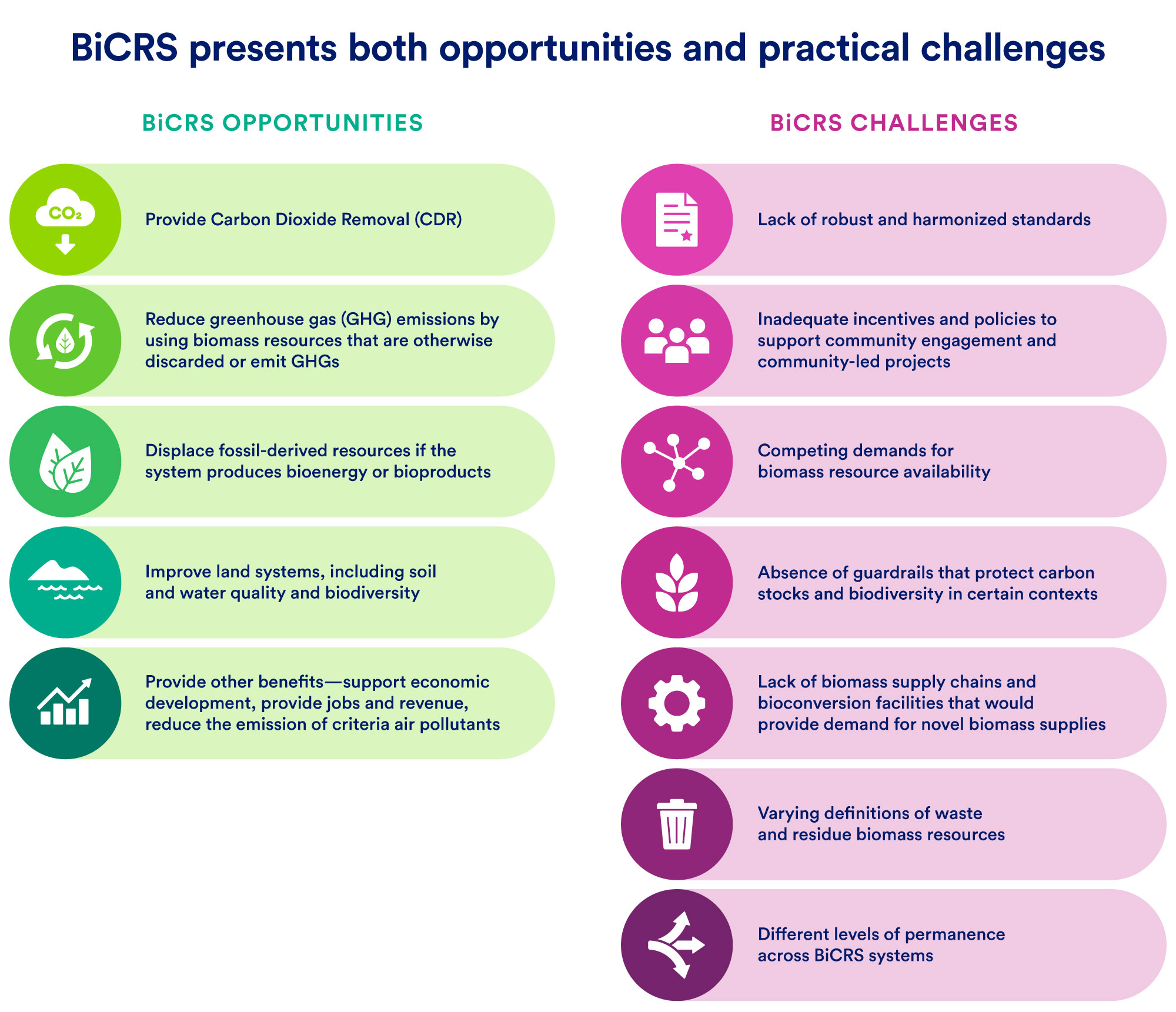
Unlocking the Potential of Biomass Carbon Removal and Storage: Highlights from New York Climate Week
Additional Contributors: Charlotte Levy, Carbon180; Dan Sanchez, Carbon Direct; and Audrey Denvir, World Resources Institute
During New York Climate Week, Clean Air Task Force (CATF) brought together experts from Carbon180, Carbon Direct, the National Wildlife Federation, and World Resources Institute to present and discuss the opportunities and challenges of Biomass Carbon Removal and Storage (BiCRS), a suite of systems that utilize biomass resources and bioconversion technologies to achieve net removal of carbon from the atmosphere into durable storage, sometimes producing bioenergy and bioproducts.
Biomass Carbon Removal and Storage (BiCRS) offers a significant opportunity to contribute to climate mitigation by removing carbon dioxide from the atmosphere, capturing emissions from biomass resources that would otherwise release greenhouse gases, displacing fossil-derived resources, and improving land systems and waste management. But many BiCRS approaches do not currently exist at scale, and the voluntary and compliance markets to support them are just emerging. Scaling BiCRS will require innovation across technologies and supply chains, backed by robust standards and effective sustainability and social safeguards.
When harvested responsibly, certain biomass feedstocks—like agricultural and forestry residues—can be used to permanently store the carbon that plants naturally sequester. According to the Road to Removals report by Lawrence Livermore National Laboratory, BiCRS products such as biochar, bio-oil, or geologically sequestered carbon could deliver millions of tons of durable carbon removal each year in the U.S., alongside providing energy, products, and ecosystem services.
However, markets, policy frameworks, and value chains are still in their infancy. Voluntary carbon markets currently drive most BiCRS projects, while only a handful of compliance programs have emerged. Building credible and scalable BiCRS systems will require clear policy signals, durable market frameworks, and strong alignment across public and private stakeholders.
Ensuring standards and safeguards for credibility
Ensuring BiCRS delivers genuine climate benefits depends on rigorous standards, safeguards, thoughtful policies, and community engagement. CATF’s forthcoming assessment of BiCRS carbon crediting protocols reveals the need for harmonization of methodologies and the use of high-quality default values to reduce barriers to innovation while ensuring emissions benefits. Narrow system boundaries or counting avoided emissions as removal can inflate crediting and undermine climate integrity.
Harmonizing protocols and ensuring the accuracy of definitions and carbon accounting across all categories of biomass resources will be essential to building market credibility.
Key challenges remain, including the need for deeper community engagement, more resilient and decentralized biomass supply chains, and strategies to manage competing demands for limited sustainable biomass resources. Modeling from the World Resources Institute estimates that demand for biomass for energy and carbon removal could soon outstrip the sustainable supply, making careful allocation and prioritization critical. Research from Carbon Direct underscores the importance of accurate permanence assessments, cautioning that certain methods – such as random reflectance techniques – may overstate biochar’s durability and risk inflating crediting claims. Analysis from the National Wildlife Federation highlights the need to avoid “carbon tunnel vision” by ensuring BiCRS systems deliver multiple societal benefits beyond carbon removal, including supporting biodiversity, reducing nitrogen pollution, and improving soil health. Findings from Carbon180 emphasize that successful BiCRS deployment must be grounded in community and regional contexts, with systems designed at appropriate scales to balance environmental, social, and economic considerations. Smaller community-led BiCRS projects may help manage impacts more effectively, while innovative financing and cost-share models could enable shared or mobile infrastructure that better serves local needs.
Taken together, these insights highlight that scaling BiCRS responsibly requires careful design, robust accounting, and integrated approaches that deliver climate, environmental, and community benefits. With the right safeguards and frameworks in place, BiCRS can become a durable, equitable, and multifunctional tool in the carbon removal portfolio.
Biomass resources are available, but they are not interchangeable. We need to build systems that match the right biomass with the right project, for the greatest social benefits.

A suite of fit-to-purpose projects can build the trust, data, and capacity that a larger bioeconomy will depend on.
Scaling BiCRS for lasting community and climate impacts
Scaling BiCRS responsibly offers a unique opportunity to deliver durable carbon removal while supporting climate, environment, and communities. When done well, it can provide low-cost, durable carbon removal from biomass resources like wastes and residues, reducing emissions, enhancing soil health, minimizing reactive nitrogen losses, and creating rural economic opportunities.
With strong safeguards and smart accounting, BiCRS can sequester carbon for the long term, support decarbonization in hard-to-abate sectors, improve land systems, and create new opportunities for farmers and rural communities. It’s a critical piece of a bigger energy system transformation and carbon removal portfolio.
CATF and partners are calling for the establishment of the necessary standards and enabling environments to initiate real demonstration projects today. Responsible BiCRS deployment can deliver lasting climate, environmental, and social benefits, but only if it’s built on a foundation of integrity, innovation, and inclusion.





